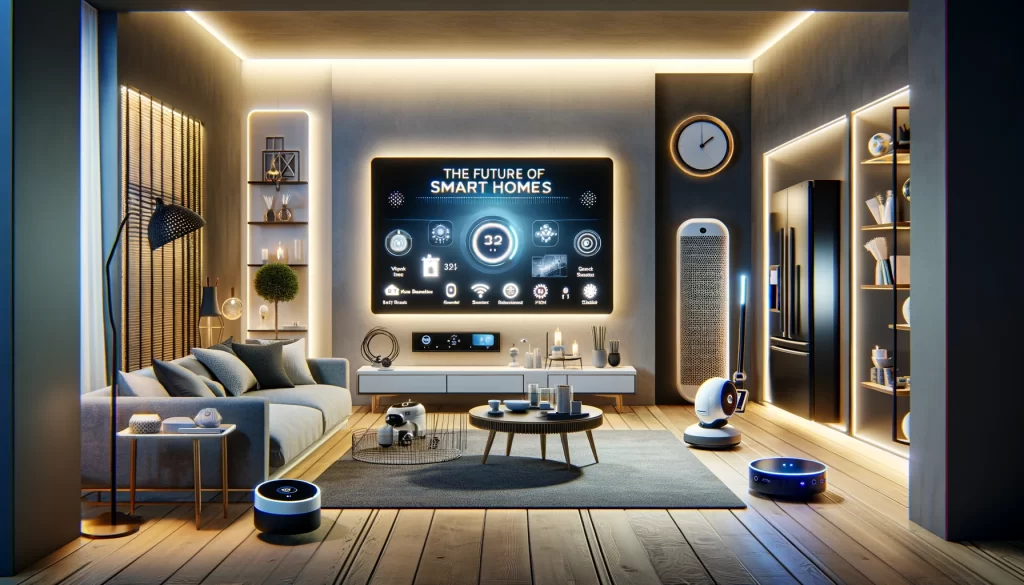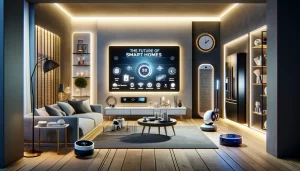
Introduction
The rise of smart home technology is revolutionizing the way we live, offering unparalleled convenience, security, and efficiency. As we look towards the future, it’s clear that smart homes will become increasingly sophisticated, leveraging cutting-edge innovations to provide an even more seamless and integrated living experience.
What Are Smart Homes?
Smart homes utilize internet-connected devices to manage and control various household functions remotely. These homes employ advanced technologies such as artificial intelligence (AI), machine learning, and the Internet of Things (IoT) to enhance the quality of life for their inhabitants.
The Evolution of Smart Homes
From the introduction of the first smart thermostat to today’s fully integrated home automation systems, smart homes have undergone significant transformations. The journey began with simple remote-controlled devices and has progressed to include complex, interconnected ecosystems that manage everything from lighting and climate control to security and entertainment.
Key Components of Smart Homes
Smart Home Automation
Home automation lies at the heart of smart home technology. It involves the automatic control of electronic devices in your home, making everyday tasks more convenient and efficient. From scheduling your lights to adjusting the thermostat, automation simplifies home management.
Trends Shaping the Future of Smart Homes
AI and Machine Learning in Smart Homes
AI and machine learning are pivotal in enhancing smart home capabilities. These technologies enable devices to learn from user behavior, predict needs, and perform tasks autonomously, creating a more intuitive and personalized living environment.
Voice-Activated Assistants
Voice-activated assistants like Amazon Alexa, Google Assistant, and Apple Siri are becoming central to smart homes. These assistants provide hands-free control over various devices, making it easier to manage home functions through simple voice commands.
IoT Integration
The integration of IoT devices is expanding the possibilities of smart homes. IoT connects different devices and systems, allowing them to communicate and work together seamlessly. This integration leads to a more cohesive and responsive home environment.
Smart Security Systems
Smart security systems are evolving to provide more comprehensive protection. These systems include smart cameras, doorbell cameras, motion sensors, and smart locks, all of which can be monitored and controlled remotely, enhancing home security.
Energy Efficiency and Sustainability
Energy efficiency is a major focus for future smart homes. Advanced energy management systems can monitor and optimize energy use, reducing costs and environmental impact. Smart homes can integrate renewable energy sources, such as solar panels, to further enhance sustainability.
Health and Wellness Technologies
Health and wellness technologies are becoming integral to smart homes. These include smart air purifiers, sleep trackers, and health monitoring devices that help maintain a healthy living environment and monitor the well-being of the residents.
Smart Appliances
Smart appliances are designed to make daily chores easier and more efficient. From smart refrigerators that track food inventory to washing machines that can be controlled remotely, these appliances bring convenience and innovation to household tasks.
Home Entertainment Systems
Home entertainment is being transformed by smart technology. Smart TVs, streaming devices, and integrated sound systems offer a rich, immersive entertainment experience, allowing users to enjoy a variety of media seamlessly.
Connectivity and Interoperability
5G and Smart Homes
The advent of 5G technology promises to enhance the connectivity of smart homes significantly. With faster data speeds and lower latency, 5G will enable more devices to connect and communicate more efficiently, enhancing the overall performance of smart home systems.
Smart Home Platforms and Ecosystems
Smart home platforms and ecosystems play a crucial role in managing and integrating various devices. Platforms like Google Home, Amazon Alexa, and Apple HomeKit provide a unified interface to control and monitor smart home devices, ensuring interoperability and ease of use.
User Experience and Interface Design
User experience and interface design are critical in smart home adoption. A well-designed interface that is intuitive and user-friendly can make it easier for residents to interact with and control their smart home devices, enhancing overall satisfaction.
Privacy and Security Concerns
With the increasing number of connected devices, privacy and security are major concerns. Ensuring that smart home systems are secure from cyber threats and that user data is protected is essential for maintaining trust and safety.
The Role of Big Data
Big data is transforming smart homes by providing valuable insights into user behavior and preferences. Analyzing this data allows for more personalized and efficient smart home solutions, improving the overall user experience.
Smart Home Adoption Trends
Cost Considerations
The cost of smart home technology can be a barrier to adoption. However, as technology advances and becomes more affordable, we can expect broader adoption across different demographics. Cost-effective solutions and financing options are also helping to drive this trend.
Government Regulations and Standards
Government regulations and standards are essential in ensuring the safety, reliability, and interoperability of smart home devices. These regulations help protect consumers and promote the development of secure and efficient smart home technologies.
Future-Proofing Smart Homes
Future-proofing involves designing smart homes that can adapt to new technologies and changing needs. This includes ensuring that systems are easily upgradable and that they can integrate with future innovations seamlessly.
Case Studies of Innovative Smart Homes
Examining case studies of innovative smart homes provides valuable insights into the possibilities and benefits of smart home technology. These examples showcase how cutting-edge technologies are being implemented to create more efficient, secure, and comfortable living spaces.
Challenges in Smart Home Adoption
Despite the numerous benefits, there are challenges in smart home adoption, including high initial costs, privacy concerns, and the complexity of integrating multiple devices. Addressing these challenges is crucial for the widespread adoption of smart homes.
The Role of Developers and Manufacturers
Developers and manufacturers play a vital role in advancing smart home technology. Their innovations drive the development of new devices and systems, improving functionality, efficiency, and user experience.
Consumer Education and Awareness
Educating consumers about the benefits and capabilities of smart home technology is essential for its adoption. Awareness campaigns, demonstrations, and user-friendly guides can help demystify smart homes and encourage more people to embrace this technology.
Conclusion
The future of smart homes is bright, with numerous trends and innovations set to transform how we live. From AI and IoT integration to advanced security systems and sustainable energy solutions, smart homes are becoming more intelligent and efficient. As technology continues to evolve, smart homes will offer even greater convenience, security, and comfort, making our lives easier and more enjoyable.
FAQs
What are the benefits of smart homes? Smart homes offer numerous benefits, including increased convenience, enhanced security, energy efficiency, and improved quality of life. They allow for remote control and automation of household functions, making daily tasks easier and more efficient.
How do smart home devices communicate? Smart home devices communicate through various protocols such as Wi-Fi, Bluetooth, Zigbee, and Z-Wave. These protocols enable devices to connect and interact with each other, creating an integrated and cohesive system.
Are smart homes secure? Smart homes can be secure if proper measures are taken. This includes using strong passwords, keeping software up-to-date, and using devices from reputable manufacturers. It’s also important to be aware of potential vulnerabilities and take steps to mitigate them.
How much does it cost to set up a smart home? The cost of setting up a smart home can vary widely depending on the devices and systems you choose. Basic setups can cost a few hundred dollars, while more advanced systems with comprehensive automation and security features can run into the thousands.
Can smart homes save energy? Yes, smart homes can save energy by optimizing the use of electricity and other resources. Smart thermostats, lighting systems, and appliances can be programmed to operate more efficiently, reducing energy consumption and lowering utility bills.
What is the future of smart home technology? The future of smart home technology is focused on increased integration, AI-driven personalization, enhanced security, and sustainability. Innovations in connectivity, such as 5G, will also play a significant role in advancing smart home capabilities.





